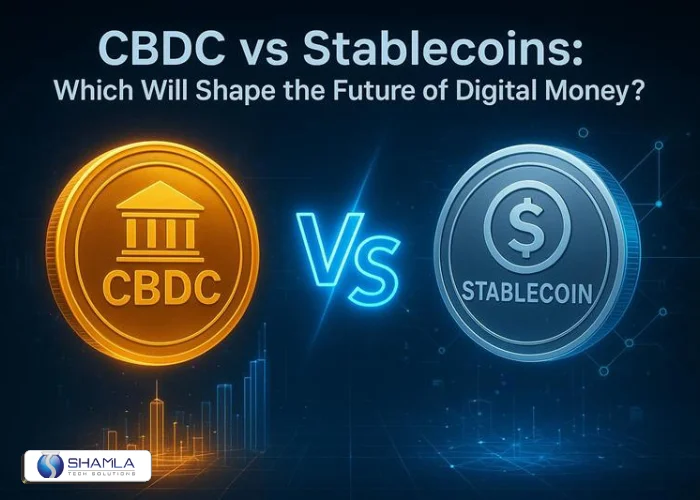Digital money moves value from cash to code. Central banks plan government-run digital cash; this is the CBDC meaning, bank accounts or tokens issued by a state. Private firms issue stablecoin digital currency tied to real money to keep value steady. CBDC vs stablecoins will shape rules for payments, privacy, identity verification, and cross-border transfers.
CBDCs offer official control and legal backing; stablecoins offer flexible rails, faster settlement, and composability with apps. Regulators will set reserve and audit rules. Businesses should prepare systems that accept both models and handle mixed clearing, wallets, and data permissions.
CBDC Meaning & The Evolution of Centralized Bank Digital Currency
Clear Definition: CBDC meaning
CBDC meaning: state-issued digital cash that sits on a bank ledger or as a token. A centralized bank digital currency is run by the national bank which sets rules, issues units, and records balances. The system can be account-based or token-based. Reserves back the units and audits check reserves.
Payments can clear instantly on a central ledger, or through bank rails. CBDC provides legal tender status and direct links to monetary policy. When comparing systems, CBDC vs stablecoins shows a shift from private settlement rails to state-managed rails with stronger legal claim and oversight. It aims to make payments traceable.
How a Centralized Bank Digital Currency Works
A central bank issues ledger entries or tokens under strict laws. The centralized bank digital currency model sets identity checks, transaction limits, and reserve rules. Banks or wallets act as onramps and do ID checks. The central ledger records who owns what and enforces rules without needing permission from private networks.
Built-in rules let the state add rules for spending or stimulus. For users and firms, CBDC meaning matters because it changes who holds money and who must meet the rules. It can speed settlement and cut cross-border transfer costs. Design also affects backup, uptime, and how quickly accounts can be frozen for fraud or law.
Global Adoption and Country Use Cases
China leads real trials with the digital yuan, using wallet apps and bank partners. The European Union plans a digital euro pilot for retail payments and cross-border use. India tests a digital rupee for fast government payouts and reduced cash costs. Each project uses a centralized bank digital currency model with offline modes, privacy settings, and bank integration.
Design choices differ: tiered access, data minimization, or full trace logs. These tests show CBDC vs stablecoins and user choice. Market players also watch how stablecoin digital currency systems react to these national moves. Regulators now publish guidance on reserves and audits.
Key Differences: CBDC vs Stablecoins
CBDC vs stablecoins split on who issues, who holds reserves, and enforces rules. CBDC gives legal tender backed by the state and a direct link to central bank policy. Stablecoins are issued by private firms and tie value to fiat or assets. For banks and apps, CBDC shifts who holds customer money and who answers to courts.
Stablecoins offer fast rails and work with apps but face counterparty risk and market runs. Under the new rules, audits, reserve proof, and clear custody rules decide which model suits payments, lending, or cross-border work. Regulators will set tech and legal guardrails.
Altcoins, Stablecoins, and CBDC - Quick Context
Altcoins are token projects that chase growth, while stablecoins aim for steady value to act like money. Compare altcoins vs stablecoins on volatility, use case, and reserve rules. Where altcoins seek price gains, stablecoins back value with cash, bonds, or crypto collateral and focus on payments and trading.
CBDC designs may borrow stablecoin features like set rules or token wallets, but keep state control. For developers and firms, choices depend on compliance, speed, and who holds funds. Firms building wallets or games must plan for ability to work across systems, bridging, and clear reserve reporting. This shapes which money works best where.
Stablecoins Explained: Types, Uses & Development
What Are Stablecoins And Why They Matter
Stablecoins are tokens that keep value steady by linking to cash or assets. People pick stablecoin digital currency for quick payments, low fees, and to hold value outside banks. Issuers hold reserves or use simple code rules to keep the peg steady and redeem on demand. Traders, apps, and shops use stablecoins for instant transfers and final settlement without long waits.
Stablecoins let builders add money features to apps without bank steps, lowering friction for payouts and commerce. These tokens work in wallets, cards, and APIs so firms plug them into flows fast. They cut exchange frictions and settlement delays.
Types Of Stablecoin
There are clear types of stablecoin: fiat-backed, crypto-backed, algorithmic, and yield models. Fiat-backed tokens hold cash or bonds in reserve to match tokens and allow redemptions. Crypto-backed models lock crypto as extra cover and often use over-collateral to protect redemptions.
Algorithmic models use code to add or remove tokens to keep the peg. Yield-Bearing Stablecoins add small returns by routing interest into pools or lending slices. Pick types of stablecoin based on risk profile, speed need, and cost trade offs. Test reserve proofs, run audits, and limit redemption runs before launch in production.
Technology And Adoption: Stablecoin Vs CBDC
From a tech and adoption view, stablecoin vs CBDC comes down to control, rails, and where money sits. CBDC vs stablecoins split on who issues legal tender, who logs transactions, and who sets policy. CBDC designs use a central ledger and give states direct control over supply, privacy rules, and enforcement.
Stablecoins run on public chains or private rails and focus on app work, fast swaps, and composability. Adoption needs wallets, bank links, merchant setups, and clear rules. Planners must map clearing, FX steps, and privacy when weighing stablecoin vs CBDC options, and run recovery drills regularly.
Market Leaders: Top 10 Stablecoins And Their Role
Market leaders show where liquidity and trust sit in live markets. The top 10 stablecoins power exchanges, lending pools, and payments with large daily flow and deep books. The top stablecoins act as main rails between fiat and crypto and host most market-making flows across pairs.
Stablecoin vs Bitcoin is plain: stablecoins keep value steady for payments while bitcoin is a volatile store and trade asset. For firms, CBDC vs stablecoins will change which rails they pick for settlement, treasury, and liquidity management across platforms. Exchanges, wallets, and merchants build failover paths and reserve checks for operational safety.
Use Cases: Stablecoin In Web3 Gaming And DeFi
Gaming and DeFi use stablecoins for stores, rewards, and instant trades inside apps. stablecoin in Web3 gaming lets players buy items with fixed value and removes price shock for users and teams. Many studios accept stablecoin in Web3 gaming payments to link in-game items to real value and merchant payout.
DeFi uses stablecoin digital currency for lending, pools, staking, and liquidity that apps trust for yield. Yield-Bearing Stablecoins plug into lending stacks so users earn while the peg holds. Builders add oracles, bridges, and fraud checks and speed settlement across chains to keep user funds safe.
Building Stablecoins: Development, Costs, And Hiring
Teams map how to create a stablecoin and list legal test steps. A stablecoin development company can provide white label stablecoin services and hire stablecoin developers. Ask that stablecoin development company for cross-chain stablecoin bridges, mint controls, and custody. stablecoin development solutions include proof of reserves, mint controls, and reporting; these set the cost of stablecoin development.
Compare the cost of stablecoin development across vendors and pick white label stablecoin services or custom stablecoin development solutions for control. If short-staffed, hire stablecoin developers or contract a stablecoin development company for audits and security. Plan for CBDC vs stablecoins and test stablecoin digital currency flows.
The Future of Digital Money: CBDC vs Stablecoins
1. Systemic Role
2. Practical Tradeoffs
3. Trust, Privacy and Control
4. Future Scenarios
5. Enterprise Adoption
Conclusion
Both systems bring clear benefits. CBDC vs stablecoins offer state-backed legal money and fast private rails. Banks gain control and traceability; apps gain speed and composability. Firms must plan for reserve checks, identity rules, and interoperability. The path forward favors systems that work together, not replace each other but adapt
Shamla Tech builds stablecoin systems and has helped 50+ businesses across the globe to build secure and reliable stablecoins. We are a leading stablecoin development company offering stablecoin development solutions worldwide. Our services include minting engines, custody, cross-chain bridges, proof-of-reserves, wallet SDKs, white label stablecoin services, compliance tools, security audits, ongoing support.
Launch your Stablecoin today with Shamla Tech!
Contact us now for trusted stablecoin development solutions!





